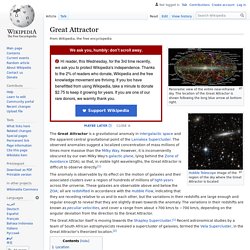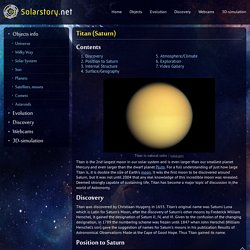

Great Attractor. An apparent gravitational anomaly at the center of the local Laniakea Supercluster Panoramic view of the entire near-infrared sky.

The location of the Great Attractor is shown following the long blue arrow at bottom right. Hubble Telescope image of the region of the sky where the Great Attractor is located We ask you, humbly: don't scroll away. Hi reader, this Wednesday, for the 3rd time recently, we ask you to protect Wikipedia's independence. Thank you! The Great Attractor is a gravitational anomaly in intergalactic space and the apparent central gravitational point of the Laniakea Supercluster. The anomaly is observable by its effect on the motion of galaxies and their associated clusters over a region of hundreds of millions of light-years across the universe. Location[edit] Debate over apparent mass[edit] Dark flow[edit] In astrophysics, dark flow is a possible non-random component of the peculiar velocity of galaxy clusters.
Laniakea Supercluster[edit] Vela Supercluster[edit] Your Guide to the Solar System. Star Atlas - Interactive star map of the night sky. Astronomy Magazine - Interactive Star Charts, Planets, Meteors, Comets, Telescopes. JOHN'S SKYNOTES - www.jonvran.co.uk. Heavens-Above. Titan – Saturn's moon, satellite, 2nd largest moon, geography like Earth. Contents Titan is the 2nd largest moon in our solar system and is even larger than our smallest planet Mercury and even larger than the dwarf planet Pluto.

For a full understanding of just how large Titan is, it is double the size of Earth's moon. It was the first moon to be discovered around Saturn, but it was not until 2004 that any real knowledge of this incredible moon was revealed. Deemed strongly capable of sustaining life, Titan has become a major topic of discussion in the world of Astronomy. Discovery Titan was discovered by Christiaan Huygens in 1655. Position to Saturn Artist's impression of Saturn View from Titan / iasos.com Titan's rotational period is about 15 days and 22 hours at an inclination of 0.348 degrees and is tidally locked to Saturn at a distance of approximately 7.5 million km (1.2 million miles). Internal Structure Surface/Geography Atmosphere/Climate. Solar System: Things to Know This Week.
Moon Phases 2016 – Lunar Calendar for London, England, United Kingdom. 10 Coolest Non-Planetary Objects In Our Solar System. Space Space is awesome.

There’s no arguing that. But all of the really cool stuff is way out there—beyond the edges our solar system—in deep space. In fact, our solar system is pretty lousy. Everyone learns about it in first grade: You’ve got nine planets (or eight since Pluto got the boot), a few boring moons flying around them, the Sun, and that’s pretty much it—right? 10 The Asteroid With Its Own Moon Logic would dictate that anything smaller than a planet doesn’t have the gravitational pull to hold onto a moon, but thats not always the case. 9 Io If ever there was a world that should remind you of Hell, it’s Jupiter’s moon Io. The eruptions on Io can be enormous, coating over 30 square kilometers (11.6 sq mi) in volcanic material, and they can be seen from space.
Io’s route through Jupiter’s magnetosphere causes it to generate great amounts of electricity that make lightning storms in Jupiter’s upper atmosphere. 8Pluto Isn’t Anything Like We Thought 7 Mimas 6 Ganymede And beyond that? Where is the ISS? Astronomy Picture of the Day Archive. Photography of Curiosity Landing Site on Mars First HD Panorama of Gale Crater. Directory Listing For / If the Moon Were Only 1 Pixel - A tediously accurate map of the solar system.
Mercury Venus Earth You Are Here Moon Mars Jupiter Io Europa Ganymede Callisto Saturn Titan Uranus Neptune Pluto(we still love you) That was about 10 million km (6,213,710 mi) just now. Pretty empty out here. Here comes our first planet... As it turns out, things are pretty far apart. We’ll be coming up on a new planet soon. Most of space is just space.
Halfway home. Destination: Mars! It would take about seven months to travel this distance in a spaceship. Sit back and relax. Suspicious0bservers. Scope. SKY-MAP.ORG. Super Planet Crash - Can you feel the gravity? All In Perspective. Astronomy Magazine - Interactive Star Charts, Planets, Meteors, Comets, Telescopes. The Solar System. Our solar neighborhood is an exciting place.

The Solar System is full of planets, moons, asteroids, comets, minor planets, and many other exciting objects. Learn about Io, the explosive moon that orbits the planet Jupiter, or explore the gigantic canyons and deserts on Mars. The-scale-of-the-universe-2.swf (application/x-shockwave-flash Object) Lunar Calendar 2012. The Hubble Heritage Project Website. 32 Nearby Stars. Known Planetary Systems. Eyes on the Solar System. World_sunlight_map_rectangular.jpg (JPEG Image, 1600 × 887 pixels) - Scaled (62%)